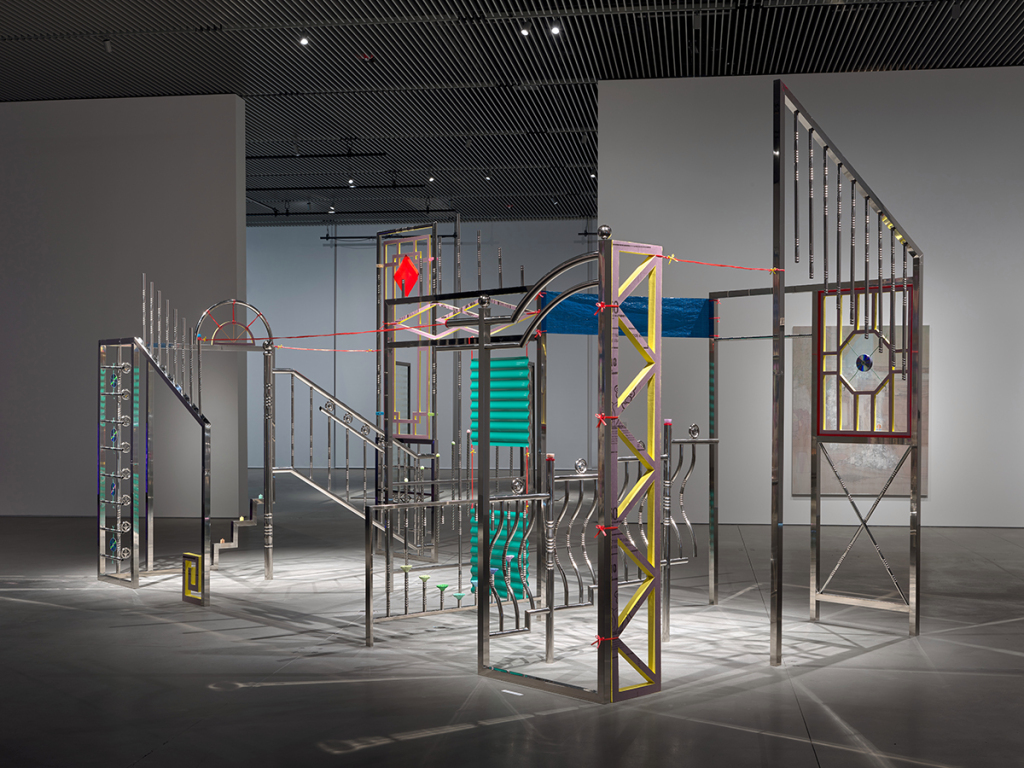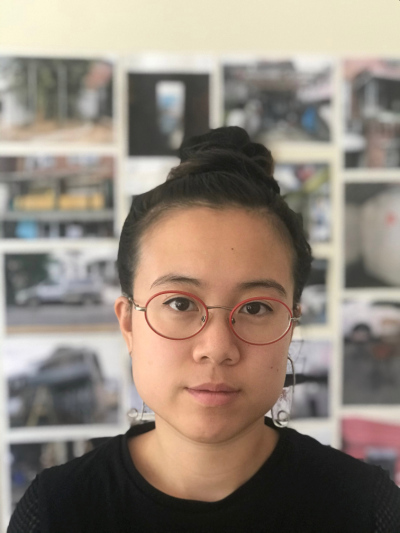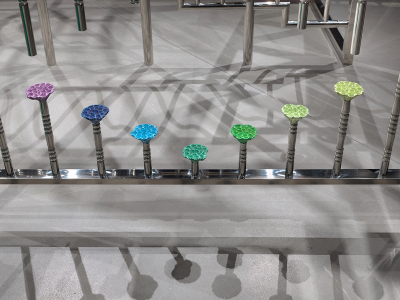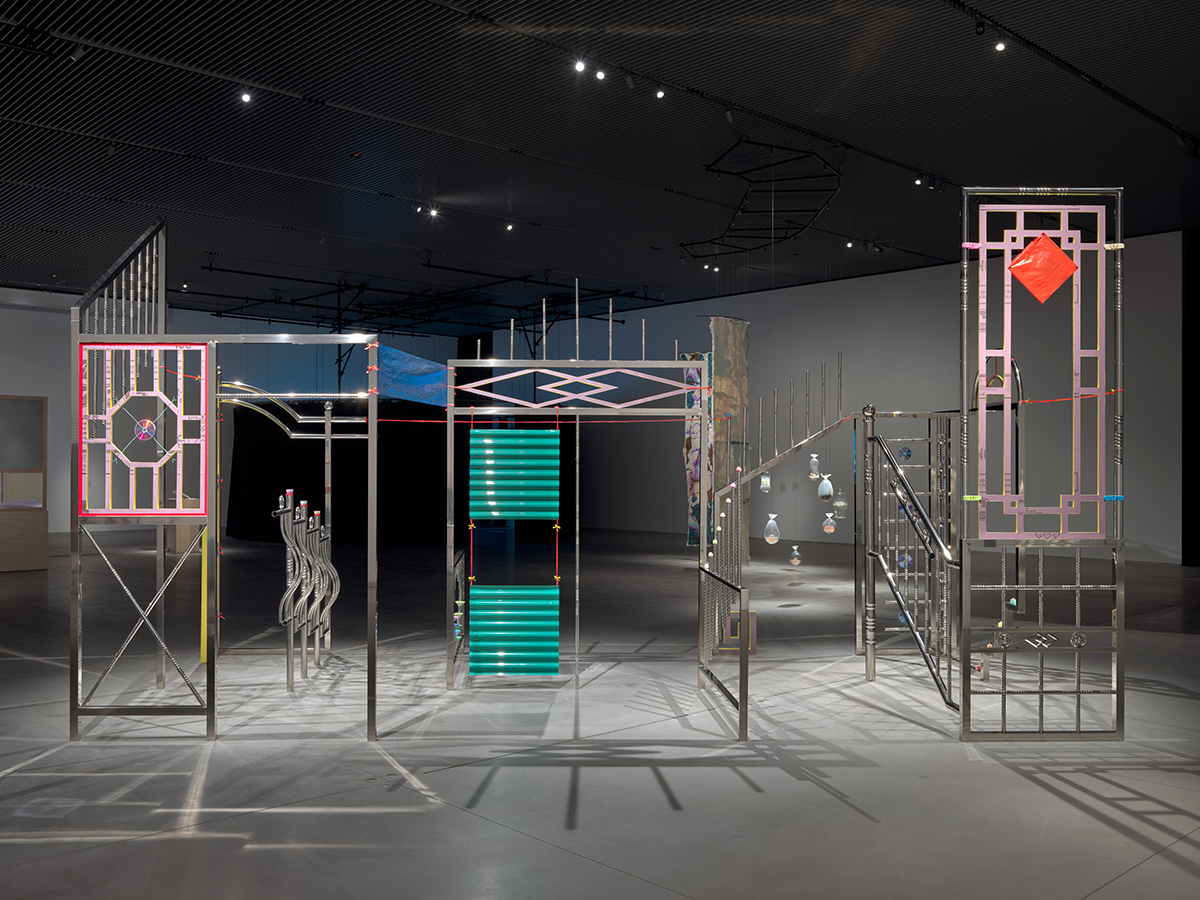 Anne Wu: A Patterned Universe, 2021, stainless steel, rigid insulation foam, tinted joint compound, PVC roof panel, tarp, plastic packing rope, cast and found objects, 10 by 20 by 12 feet; at the Shed, New York. Ronald Amstutz
Anne Wu: A Patterned Universe, 2021, stainless steel, rigid insulation foam, tinted joint compound, PVC roof panel, tarp, plastic packing rope, cast and found objects, 10 by 20 by 12 feet; at the Shed, New York. Ronald Amstutz  Portrait of Anne Wu. Courtesy the artist
Portrait of Anne Wu. Courtesy the artist
Anne Wu, who received her MFA from Yale University in 2020, is an emerging sculptor and installation artist whose work reflects the material culture and collective experience of Chinese immigrant communities. Wu’s sculptural installation A Patterned Universe (2021) features architectural materials such as polished stainless-steel rods, red string, insulation foam, and PVC roof panels sourced from her immigrant neighborhood of Flushing, Queens. With the help of a fabricator known as Mr. An from New Tengfei Stainless Steel, Wu created an installation that evokes liminal spaces by affixing unfinished staircases, doorways, and windows to the walls and floor of a gallery. Below, Wu discusses how she came to see found materials from her neighborhood as conveyors of Chinese cultural heritage and current socioeconomic conditions. “Open Call: Anne Wu” is on view at the Shed in New York through August 1.
I first started thinking about stainless steel, one of the predominant features of the installation, on a research trip in 2019. I felt I needed to expand my purview and gain critical distance by seeing examples of Chinese communities in other locations. On a small grant, I traveled to four different Chinatowns across North America. Originally, I was searching for examples of shared cultural imagery. But I came to realize that every iteration has its own very unique backstory and reasons for existing—some were constructed for tourists, while others are real neighborhoods where Chinese people actually live. It’s important to me to show this dichotomy of the interior and exterior presentations of Chinatowns and Chinese neighborhoods.
The last place I visited was La Chinesca, a neighborhood in the Mexican border town of Mexicali, which was populated by Chinese immigrants in the late 19th century who left the US after the Chinese Exclusion Act. Mexicali’s Chinatown has very interesting aesthetics such as large arches and murals with figures like Bruce Lee. A lot of the people in the community have grandparents who immigrated from China. It got me thinking about how different types of distance—generational, physical, or emotional—impact one’s relationship to immigration. While there was some shared imagery among the Chinatowns I visited, I became more interested in the idiosyncrasies of these neighborhoods and the rich interior connections between individuals and their community.
 Anne Wu: A Patterned Universe (detail), 2021, stainless steel, rigid insulation foam, tinted joint compound, PVC roof panel, tarp, plastic packing rope, cast and found objects, 10 by 20 by 12 feet; at the Shed, New York. Photo: Ronald Amstutz, courtesy the Shed
Anne Wu: A Patterned Universe (detail), 2021, stainless steel, rigid insulation foam, tinted joint compound, PVC roof panel, tarp, plastic packing rope, cast and found objects, 10 by 20 by 12 feet; at the Shed, New York. Photo: Ronald Amstutz, courtesy the Shed
This experience prompted me to consider my own relationship to Flushing from a material perspective. While stainless steel fixtures were something I had seen tacked onto buildings throughout my neighborhood, it has become much more popular in the last ten years and has now spread to other neighborhoods in New York. I didn’t see this material being used in the American West. It gave me the opportunity to really see my own neighborhood with fresh eyes and employ materials that I now know are localized to where I grew up. From there, I started collecting scraps of stainless steel from dumpsters in an industrial part of Flushing. Eventually, I found Mr. An, a local fabricator who now helps construct my pieces.
The stainless steel is, for the most part, imported from China. It has a mirror finish and, with it, an ability to reflect the world around it. In that sense, it kind of blends in, but at the same time, it’s so shiny that it makes its presence really known.
In the context of Flushing, these fixtures have typically been retrofitted onto an existing structure—like, say, a Tudor-style house. There’s not really a sense of cohesion, which makes the stainless steel feel like a very bold statement. But their presence also suggests that there is not enough money to renovate the whole house, just this one part. The material is a way to express a certain kind of taste and, to me, it feels like a very specific emblem of a non-Western bourgeois life. There exists a desire to connect and to have a sense of cultural continuity with what might be happening back home, as metal and steel decoration is prevalent in many parts of Asia.
 Anne Wu: A Patterned Universe, 2021, stainless steel, rigid insulation foam, tinted joint compound, PVC roof panel, tarp, plastic packing rope, cast and found objects, 10 by 20 by 12 feet; at the Shed, New York. Photo: Ronald Amstutz, courtesy the Shed
Anne Wu: A Patterned Universe, 2021, stainless steel, rigid insulation foam, tinted joint compound, PVC roof panel, tarp, plastic packing rope, cast and found objects, 10 by 20 by 12 feet; at the Shed, New York. Photo: Ronald Amstutz, courtesy the Shed
For this show, I really wanted to create a walk-through experience using stainless steel for its cultural significance and for its close association with the place that I was getting it from. I was really excited about collecting unfinished pieces from Mr. An and allowing them to play out in different moments such as the unfinished staircase. There’s something about being an immigrant that always feels unfinished and meandering. I see many of my recent sculptures as unfinished sentences in the way that they’re installed and how things can suddenly drop into space.
There’s a sense of strength projected by the strong material, but each piece is also very delicate because of the way they were constructed, with tack welding. Having Mr. An help with the framing gave me the freedom to work on the placement of smaller objects throughout—among them, red string. I had more time to play with knots and to think about different methods of attachment, both physical and metaphorical, which leads into themes of distance and impermanence. For example, the strings loosen a bit more every week the installation remains at the Shed.
It was important to me to have unique moments throughout the show, like those I experienced in various Chinatowns and, of course, in my own neighborhood. All of these elements make up a small universe. Visitors can linger there in a transitional place and contemplate, if they so choose, that indefinable space between the front door and the sidewalk that one normally moves through quickly. I’m asking: what can happen if you just stay there?
—As told to Francesca Aton
Source link : https://www.artnews.com/art-in-america/interviews/anne-wu-interview-the-shed-1234599375












